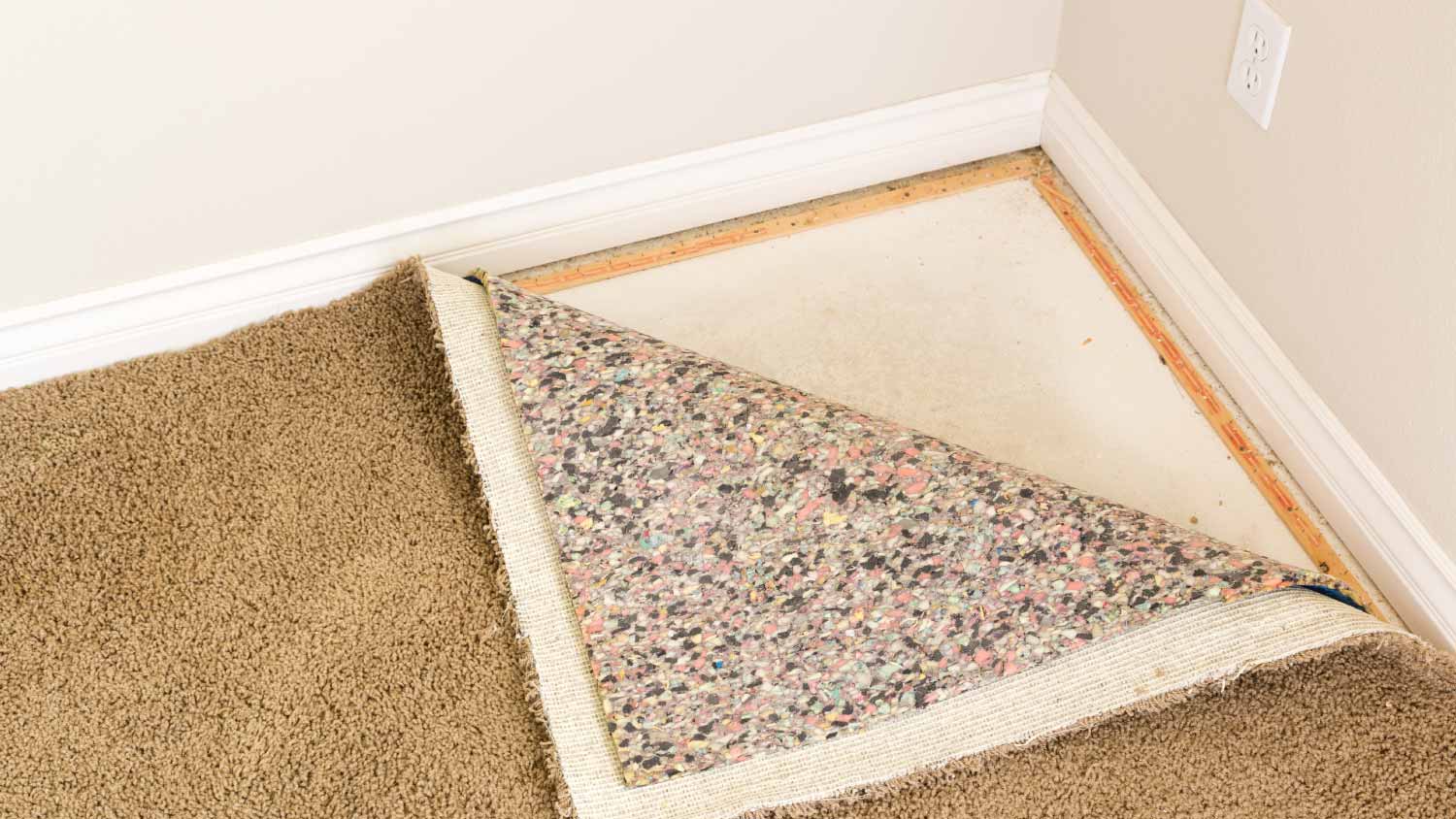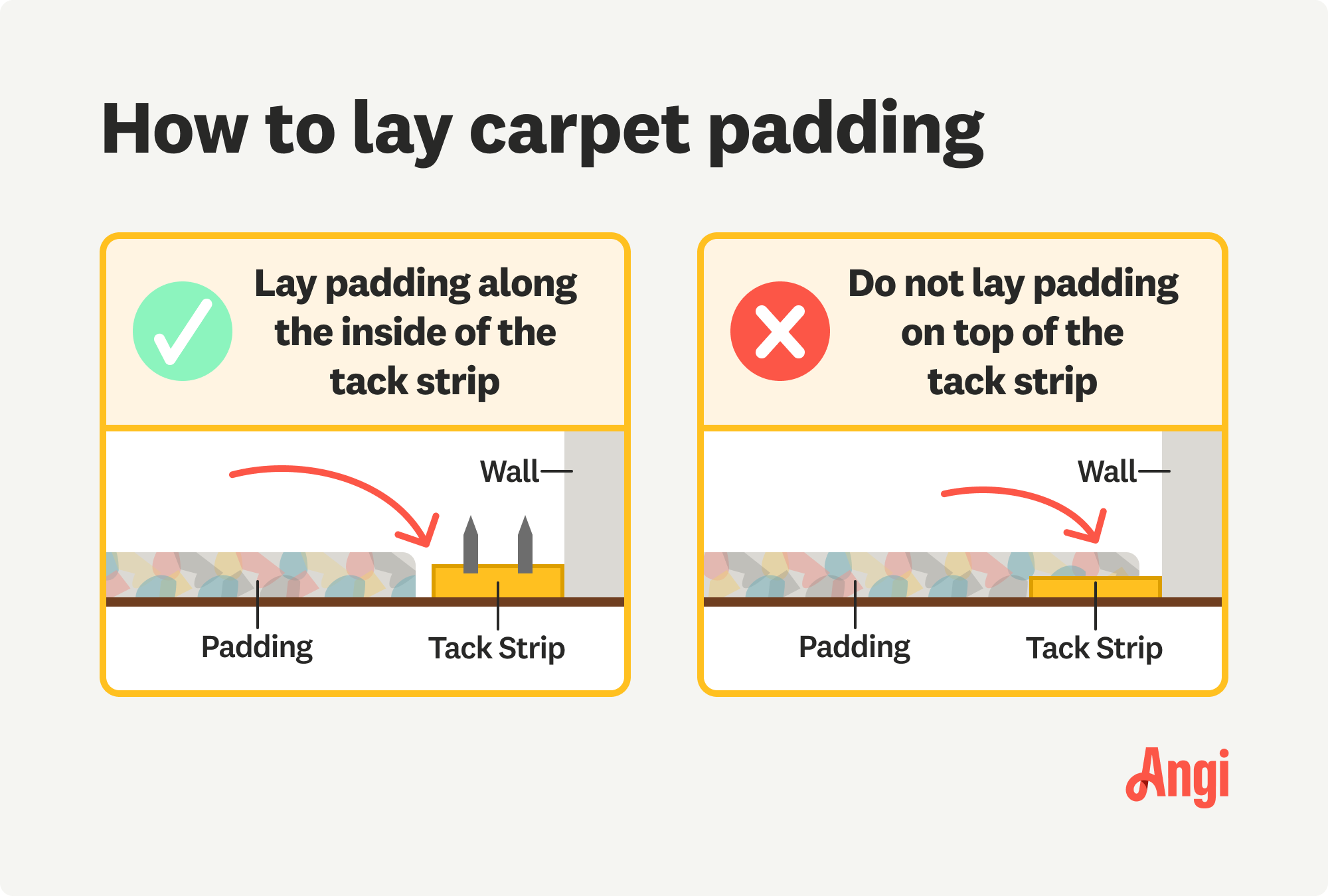How Much Does Carpet Padding Cost? [2025 Data]
Installing carpet padding costs an average of $510, but it ranges from $170 to $850. A pro will estimate the price based on the size and type of padding.


Need help budgeting for new carpet padding? Across the country, the average carpet padding cost for a 225-square-foot room is $510, or $0.75 to $3.75 per square foot, including materials and installation. However, it’s common for this project to cost between $170 and $850, based on the padding material and other factors.
Carpet Padding Cost Factors

When calculating the cost to install carpet padding, you need to consider the size of your space, the padding material, and labor rates in your area. Here’s how each of these factors influences your overall project price.
Carpet Pad Cost per Square Foot
Like many other home improvement jobs, the price of adding carpet padding to your home will depend on how much ground you have to cover (quite literally). So, how much is carpet padding per square foot? On average, it costs between $0.75 and $3.75 per square foot, including the materials and installation.
Whether you’re adding carpet padding to a 10-by-12-foot room or an entire 2,000-square-foot house, here’s how much you can expect to pay based on the size of your space.
| Square Footage | Average Cost (Materials and Installation) |
|---|---|
| 200 | $150–$750 |
| 400 | $300–$1,500 |
| 600 | $450–$2,250 |
| 800 | $600–$3,000 |
| 1,000 | $750–$3,750 |
| 2,000 | $1,500–$7,500 |
Material
Carpet padding comes in numerous materials, with prices ranging from $0.25 to $3 per square foot for the padding itself. With installation, these costs increase to $0.75 to $3.75 per square foot.
Here are some of the most popular padding options on the market today, as well as how much each one costs, including professional installation.
| Material | Average Cost per Sq. Ft. (Materials Only) | Average Cost per Sq. Ft. (Materials and Installation) | Pros | Cons |
|---|---|---|---|---|
| Rebonded foam | $0.25–$0.80 | $0.75–$1.55 | Budget-friendly, made of recycled foam, durable, and variety of thicknesses and densities | Not ideal for busy areas |
| Prime foam | $0.25–$1.50 | $1–$2.25 | Cost-effective, lightweight, and a soft underfoot feel | Not as durable, internal air pockets eventually give way, and not a good fit for busy areas |
| Fiber, jute, or felt | $0.35–$1.25 | $0.85–$2 | Less expensive, long-lasting, blocks sound, effective in busy areas, and reduces wrinkles and stretching | Not as soft underfoot, susceptible to mold growth, and holds onto dirt and dust |
| Waffle rubber | $0.50–$1 | $1–$1.75 | Soft underfoot feel and less expensive | Doesn’t last as long |
| Memory foam | $0.50–$1 | $1–$1.75 | Soft underfoot feel and more comfortable | More expensive, stretching can cause damage, and not as tough |
| Frothed foam | $0.50–$2 | $1–$2.75 | Long-lasting, works in busy areas, and is more sturdy | Higher cost |
| Flat rubber | $0.75–$3 | $1.25–$3.75 | Dense, durable, works in busy areas, and is long-lasting | Higher cost |
Labor
In most cases, carpet padding is added as part of a larger carpet installation project. If so, labor costs may be included in the price provided by your carpet professional. Otherwise, pros charge about $0.50 to $1 per square foot for labor.
Since these costs vary from company to company, it’s always a good idea to shop around and request pricing from multiple companies to get the best deal.
Carpet and Carpet Pad Removal
If you currently have carpet or carpet padding in the places where you plan to add new padding, you’ll need to remove the old stuff first. On average, carpet removal costs between $0.50 and $5 per square foot.
You’ll pay more if the carpet is difficult to remove, whether that’s due to the location—for example, dismantling carpeted stairs is trickier than pulling carpet out of an empty bedroom—or because of how it was attached—glued carpet is harder to remove than stapled carpet.
Subfloor Repairs or Replacement
Carpet padding attaches to your subfloor, so you’ll also need to consider the cost of preparing it for installation. The subfloor must be level, damage-free, clean, and dry before adding padding to ensure it lies flat.
If the subfloor’s surface is uneven or cracked, your carpet installer will need to fix it before laying your carpet padding. On average, repairing or replacing a subfloor costs between $3 and $10 per square foot.
Furniture Moving
Carpet installation companies handle furniture moving in one of four different ways:
Adding a flat fee to the service, around $100 to $200, plus $50 to $100 for particularly large, heavy furniture pieces
Including the service in their base cost at a higher rate per square foot
Including an extra service charge per square foot of installation area or for each item moved
Expecting the customer to handle furniture removal themselves or with a moving company
Always ask pros how they handle furniture when collecting estimates. If they charge extra for this service, learn about their fee structure. Consider which option will cost more for you based on your home’s layout.
DIY Carpet Padding Installation vs. Hiring a Pro

As a standalone project, installing carpet padding isn’t particularly complicated. The process involves rolling out the padding on your subfloor and then stapling it to the edges of carpet tack strips around the perimeter of your room. By installing padding yourself, you can save up to $1 per square foot on labor. For a 15-by-15-foot room, that’s $225.
The only issue is that installing carpet padding isn’t a standalone project. That’s because once you finish laying the padding, you’ll need to install carpet above it, and that’s a far more complicated process.
Because of this, we recommend contacting a local carpet installer if you plan to replace or add carpet padding to your home. After all, laying padding is a critical part of carpet installation (and it’s often included in the total price). Another benefit of hiring an expert is that they’ll inspect your subfloor to ensure it can support your carpet and padding. That’s an important part of carpet installation preparation, and, unfortunately, it’s easy to overlook if you don’t have much DIY experience.
Cost of Common Carpet Padding Add-Ons
When you hire a pro to install carpet padding, they’ll likely perform other services at the same time. Examples of these add-ons (and their costs) include:
Carpet installation cost: $3 to $11 per square foot
Carpet repair cost: $60 per hour or $0.35 per square foot
Carpet disposal (for carpet you’ve removed yourself): $0.40 to $0.50 per square foot
How to Save Money on Carpet Padding Installation
Looking to save money on your carpet padding installation? Review your contract to understand what you need to do to prepare your home for carpet installation and what the professionals will handle. In some cases, you can reduce labor costs by tackling prep work before the pros arrive—just make sure to check with your contractor before doing so. Examples include:
Moving furniture, artwork, decor, and curtains out of the installation areas
Ensuring that there’s clear access to entryways and hallways
How Angi Gets Its Cost Data
Home is the most important place on earth, which is why Angi has helped more than 150 million homeowners transform their houses into homes they adore. To help homeowners with their next project, Angi provides readers with the most accurate cost data and upholds strict editorial standards. We extensively research project costs to develop the pricing data you see, so you can make the best decisions for you and your home. We rely on reputable sources, including the U.S. Bureau of Labor Statistics, academic journals, market studies, and interviews with industry experts—all to ensure our prices reflect real-world projects.
Want to help us improve our cost data? Send us a recent project quote to [email protected]. Quotes and personal information will not be shared publicly.
Frequently Asked Questions
If you want your carpet to last as long as possible, then yes, you need to install carpet padding. Carpet padding creates a layer of protection between the back of your carpet and the floor beneath it, which decreases friction and reduces wear and tear. Aside from that, carpet padding also helps absorb noise and makes your carpet feel more comfortable underfoot.
Most people realize it is time to replace the padding when the carpet loses springiness or feels thin and unsupportive. Other telltale signs are lumps or dips in the carpet that could look unattractive or cause tripping hazards. Similarly, if your carpet is making a crinkly sound or starting to wear out prematurely, you might need to replace your padding.
No, thick carpet padding isn’t necessarily better than thinner padding. The appropriate padding thickness will depend on the type of carpet and the amount of foot traffic in the area.
For example, thick padding works well in low-traffic areas, like bedrooms, where you have soft and plush carpeting. However, thick carpet padding can damage low-pile carpet, which is used in the busiest parts of your home (like hallways and entryways). For that reason, it’s best to use thinner, heavier padding underneath carpet in high-traffic areas.
It depends on the kind you choose, but some types of carpet padding can last for decades. For instance, flat rubber—which is dense, durable, and higher-priced than other padding materials—has a life span of up to 20 years. On the other hand, prime foam—a lower-priced material that often comes free with a carpet installation—lasts less than five years on average.















